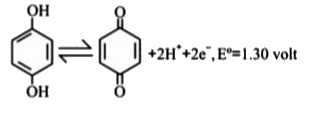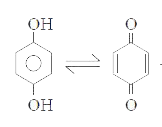For the half cell

At pH = 3 electrode potential is
1.48 V
1.20 V
1.10 V
1.30 V
The correct Answer is:A
E=E∘−0.05912log[H+]2
=1.30+0.0591×3=1.48V
Topper's Solved these Questions
- ELECTROCHEMISTRYBOOK - OP TANDONCHAPTER - ELECTROCHEMISTRYEXERCISE - Multiple Answer Type Question
5 Videos
- ELECTROCHEMISTRYBOOK - OP TANDONCHAPTER - ELECTROCHEMISTRYEXERCISE - Matrix-Matching Type Question
3 Videos
- ELECTROCHEMISTRYBOOK - OP TANDONCHAPTER - ELECTROCHEMISTRYEXERCISE - LINKED COMPREHENSION TYPE QUESTION
40 Videos
- COORDINATION COMPOUNDSBOOK - OP TANDONCHAPTER - COORDINATION COMPOUNDSEXERCISE - SBJECTIVE TYPE
96 Videos
- HALOALKANES AND HALOARENES BOOK - OP TANDONCHAPTER - HALOALKANES AND HALOARENES EXERCISE - Single Interger answer type questions
14 Videos
Similar Questions
Calculating the emf from standard potentials:
A galvanic cell consists of an Al electrode in a 1.0MAl(NO3)3 solution and an Fe electrode in a 1.0MFe(NO3)2 solution. Calculate the standard emf of this electrohemical cell at 25∘C. Also write the cell reaction.
Strategy: From the table of standard electrode potentials, write the two reduction half reaction and standard electrode potentials for the cell. Change the direction of the half-cell reaction corresponding tol the smaller (or more negative) electrode potential. Multiply the when the half-reactions are added the electrons cancel. The sum of the half-reactions is the cell reaction. Add the electrode potentials to get the cell emf.
View SolutionE1andE2 are two half-cells of electrode potential which when combined form a cell of electrode E3, then which of the following is true (where n1,n2 and nu are number of electrons exchanged in first, second and combined half cells)?
View Solution
Knowledge Check
For the half cell

At pH=2, the electrode potential isA1.36VB1.30VC1.42VD1.20VFor the half cell

At pH=2. Electrod potential is :A1.36VB1.30VC1.42VD1.20VAssertion (A) : Cu2++2e−→Cu (s) is an example of oxidation half reaction.
Reason (R) : When concentrations of all species involved in a half-cell is unity, then the electrode potential is called standard electrode potential.ABoth Assertion (A) and Reason (R) are correct statements, and Reason (R) is the correct explanation of the Assertion (A).BBoth Assertion (A) and Reason (R) are correct statements, but Reason (R) is not the correct explanation of the Assertion (A)CAssertion (A) is correct, but Reason (R) is incorrect statement.DAssertion (A) is incorrect, but Reason (R) is correct statement.
when two half-cells of electrode potential of E1 and E2 are combined to form a half cell of electrode potential E3 , then
(when n1,n2andn3 are no. of electrons exchanged in first second and combined half-cells:
View SolutionWhat is the electrode potential of a gasous hydrogen electrode dipped in a solution pH=5.0 relative to the calomel electrode with an electrode potential of +0.28V ?
View SolutionThe cell reaction involving quinhydrone electrode is :-

What will be the electrode potential at pH = 3
View SolutionFor the half cell,

+2H+2e−.E0=
1.30 V. At pH=2, electrode potential of the given quinhydrone half cell is :
View SolutionThe emf of a cell containing sodium/copper electrode is 3.05 V, if the electrode potential of copper electrode is +0.34 V, the electrode potential of sodium is :
View Solution
